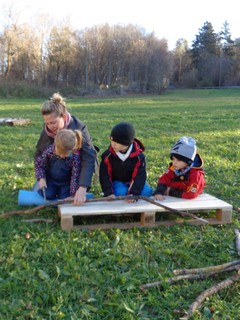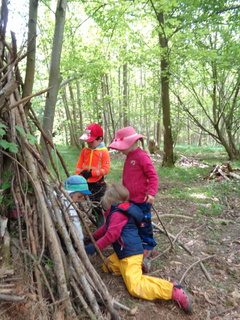Interview with Cornelia Hackner
Leader and Nature/Outdoor Education specialist of the Lumberjack bilingual forest kindergarten
Forest kindergartens are quite popular in Germany. What does a forest kindergarten actually do?
The school day of a forest kindergarten takes place entirely outdoors and in almost all weather conditions. The children play with items they find in their natural surroundings; normal toys are not used. Aside from this, children will be supported, educated and supervised as in a conventional kindergarten.
Children today are overwhelmed with media and structured free time activities; they lack the time and space to fulfill their natural urges to move. Being in nature affords us all a better sense of well being and inner harmony. Outdoor and forest kindergartens take advantage of this fact, providing children a formative, stimulating experience.
How do children react to a forest kindergarten?
There is a lot of space in the woods. Children always want to hop, skip and jump; this is always possible outdoors. Children are not disturbed and it isn’t a big deal if they run around or jump over a tree stump. Conflicts rarely arise, if ever, because the environment allows children to back away if they’re uncomfortable.
Are the learning goals any different? How are they implemented?
We will follow the Bavarian education plan, which is possible in the forest. Of course, the difference is how this is accomplished.
Much of the practice will include role-play because ready-made materials will not be used. Therefore, children will have to use their words, providing a natural method of language production. It is also proven that motor skills are embedded in speech movement and that fluency is enhanced with a great deal of movement.
Math can easily be taught in nature. From time to time, number cards will be distributed and practiced with pencil and paper, however most of the math will be learned using what the forest has to offer. For example, to understand sizing and sorting, stones and pine cones can be used. Because we’ll be building quite a lot, children will start to understand geometry, like when building a swing.
Construction also helps to promote social skills and confidence; it’s quite rare that a child builds on his or her own. Making structures like teepees usually happens in small groups, or even as a whole group.
Flexibility is also learned in the forest. Since we will be continuously changing locations in the woods, the kids have to adapt to new situations and surroundings. Also, the change of seasons and the weather also create natural change. This challenges the children to be even more flexible than they already are; it also encourages problem solving.
When you imagine kindergarten, you often envision children sitting around a table practicing letters on paper. What is that like in a forest kindergarten?
In the last year before going to school, we will make time once or twice a week to sit down with the kids and practice in this fashion. The focus will be on language and math, so that students will understand the basic concepts.
Math will be learned according to the system developed by Dr. Preiss: the implementation of math in the forest. Dr. Preiss uses a great deal of forest materials for counting and calculating. The students will have assignments such as collecting a certain amount of an item and then placing them in the area with the according number shown. For example, the children should place 5 stones on the mat with the number “5” on it, and seven pine cones on the mat marked “7”, etc.
For writing practice we will use paper, cardboard paper or card and scissors so that children will learn how to cut, paste and do crafts. We will keep the materials in our forest shed. We’ll also simply write letters and numbers in the sand. Children especially love writing numbers and letters with rope. In kindergarten it isn’t necessary to be able to write the numbers and letters pefectly, but rather be able to recognize numbers and letters and develop the relationships between them. Kids really enjoy finding the shapes in nature. For example, the fork in a tree could be a Y or an A.
How does Lumberjack implement the first bilingual kindergarten in Munich?
The immersion method: English and German are both used consistently as languages of instruction. The native German speaking teacher speaks German, the native English speaker speaks English. It is a kind of “language bath”. The students learn their second language (or both if already bilingual) in the unknowing, natural way, alongside a native speaker as a model. Since the teachers only speaks in their native language, it is easier for children to learn and understand. Eventually they will grow to use the second language themselves.
How is Lumberjack Waldkindergarten managed?
The Lumberjack forest kindergarten in Aubinger Lohe has 20 places for children from age 3 until entry into school. The teaching team is made up of an American teacher, a further staff member and, of course, me. There is be a forest shed that will be used as shelter. The children receive a warm meal every day; they should bring their breakfast with them from home. We are open from Monday through Thursday 8:00am until 3:30pm and Friday 8:00am until 2:30pm.
If you’re interested in applying to our kindergarten, please find more information here.





